Replace thermostat, improve engine performance! (Rankle 75, 1HZ engine)
- 岩本貴志

- Oct 21, 2022
- 10 min read
Updated: Mar 16, 2023
This time, I fixed a problem with the engine cooling system of my beloved car, Rankle, so I'll talk about that.
I wrote it on my blog to help you with the self-style repair that the janitor is doing as a hobby.
In fact, those who repair, please do so at your own risk.
■
My favorite car Rankle 75, where maintenance is a part of my life, it feels good to drive when the condition gets better, but I'm starting to feel lonely because there's no one to mess around with.
I don't miss it that much.
"Is there anything I can do to fix it?"
Even if you drive your child to school on a 10-kilometer round-trip route with an elevation difference of 75 meters, the engine won't warm up.
The engine should have warmed up much faster before.
After driving about 10km and reaching home, the needle of the water temperature gauge is still at the bottom.
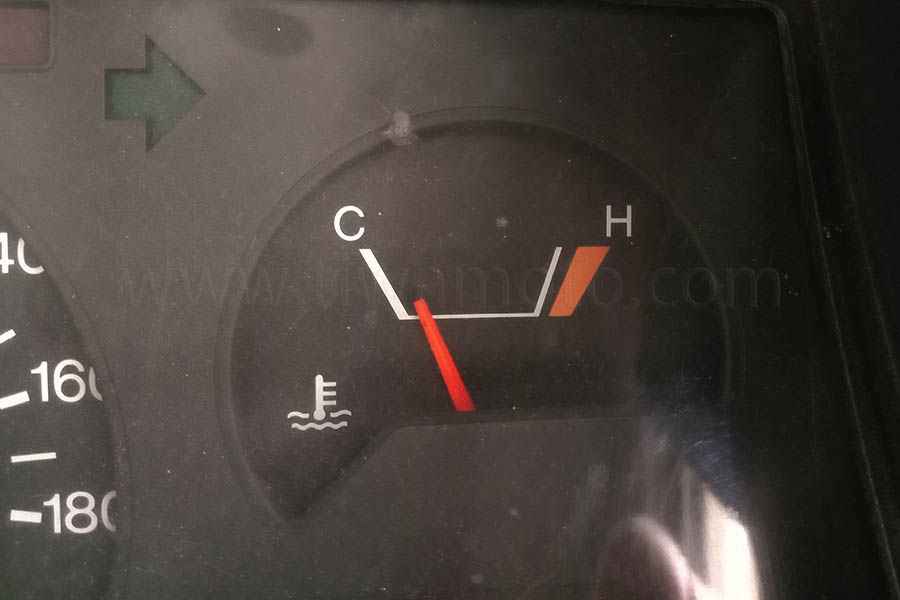
Climb down 75m height difference, run 10km and in this state, warm up for a few minutes before departure
The engine temperature displayed by the water temperature system is lower than before even during long-distance driving.
This water thermometer, the appropriate temperature is not in the middle, but around the left 1/4.
It seems that there is a problem with the cooling system that the cooling water does not warm up easily.
Possible cause
Is the thermostat valve closed even when the engine is cold?
Is the thermostat valve opening too soon?
Is there a foreign object caught in the thermostat that prevents it from closing completely?
Either way, the suspect is the thermostat.
The thermostat is causing too much coolant to flow even though the engine is not warmed up.
So I decided to replace the thermostat
A thermostat regulates the temperature of the engine at any time.
Near the appropriate temperature, it opens and closes the valve to adjust the flow rate of the cooling water and keeps the engine temperature moderate.
I feel that the opening and closing temperature of the installed thermostat was 79 degrees Celsius.
Thermostat that was removed at the time of purchase
The thermostat was removed when I purchased this car 20 years ago.
At the time of purchase, the engine temperature did not rise easily, so I noticed that the thermostat was not installed.
At that time, in Kenya, the thermostat was removed as a matter of course to prevent overheating. You can still see it now and then.
Even without a thermostat, if there is a load on an uphill road, the engine will warm up and there will be no problems, but it will naturally get too cold on a long downhill road.
The manual says never run with the thermostat removed! It is written.
Engine combustion is also optimized when the engine warms up, so the temperature rises, combustion efficiency improves, power comes out, and fuel efficiency improves. It also reduces wear and tear on the engine and extends its life.
Without the thermostat, the cooling water will always flow to the maximum, the engine will not reach the proper temperature, no power will be produced, and the fuel consumption will be poor, so it seems that there will be nothing good for the engine or the wallet.
At that time 20 years ago, I immediately purchased and installed a thermostat.
I haven't replaced the thermostat since.
During the safari, when the trouble of the radiator occurred, I removed it once.
In this car, the cooling system had its water pump replaced once about 18 years ago.
Thermostat-kun, who has been working hard for 20 years since I started riding this car.
Either way, the thermostat will last.
Go shopping at Car Goods Yokocho Kerinyaga
The thermostat of the 1HZ engine, the manager's one is 30 years old, but the engine is also used in the current Rankle HZJ79.
Even so, it's quite disappointing that the same car with the same engine has continued to be sold for over 30 years, even though minor changes have been made.
It would be a famous car among famous cars.
I agree.
I went to Kerinyaga, Car Goods Yokocho, without a sample, expecting that a new thermostat could be used.
If it doesn't work, you should return it for a replacement.
For the 20km round trip, I use my bicycle as usual! Anyway, it's fast and exhilarating!!! Moreover, it also eliminates the usual lack of exercise.
Three birds with one stone: reduction in time, elimination of lack of exercise, and cost savings due to free shipping.
The mileage is 20km round trip, and the difference in elevation is 120m. After about an hour of cycling and climbing an altitude difference of 120m, by the time you return home, you will be sweating comfortably and your heart and lungs will continue to be under a moderate load, so the exhilaration when you come back is also exceptional.
purchased thermostat
Luckily, I was able to suddenly find it at a store that sells Toyota-related parts.
I bought the thermostat below.
A genuine product installed in the current Rankle 70 series 1HZ engine.
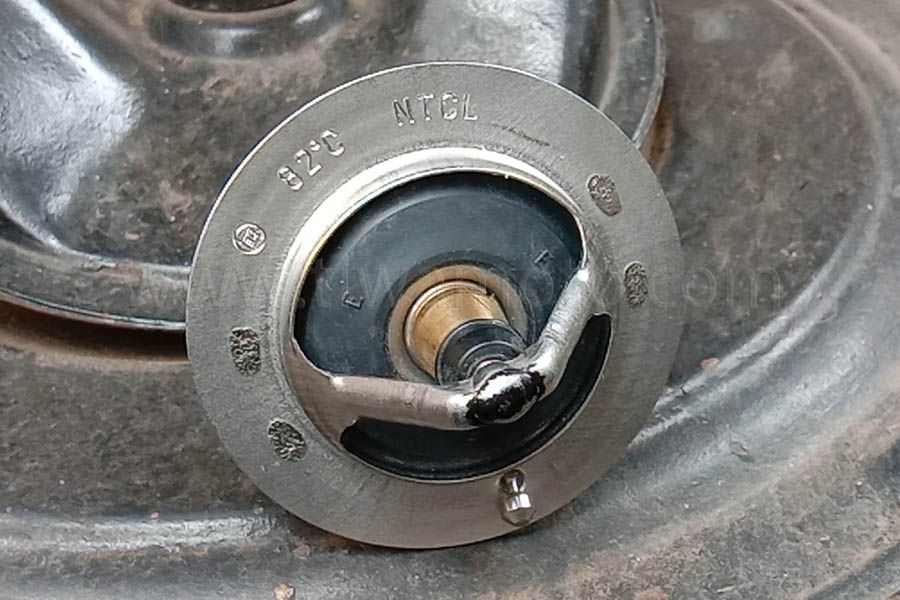
82°C Bought a genuine Toyota product for 4000 shillings About 33 US$?
At this time, the thermostat, which seems to be in bad condition, has not been removed.
I have a memory like 79 degrees Celsius, but is my memory correct?
For the same engine, I'm sure it will fit.
Remove a bad thermostat
The thermostat of the 1HZ engine of my beloved Land Cruiser HZJ75 is attached to the hose pipe that connects the radiator to the engine, right at the entrance of the engine.
The thermostat can be easily replaced by removing the bolts and hoses indicated by these yellow arrows.
Even if there is trouble in the bush, it can be easily removed with a spanner.
Remove one bolt and hose pipe under the car.
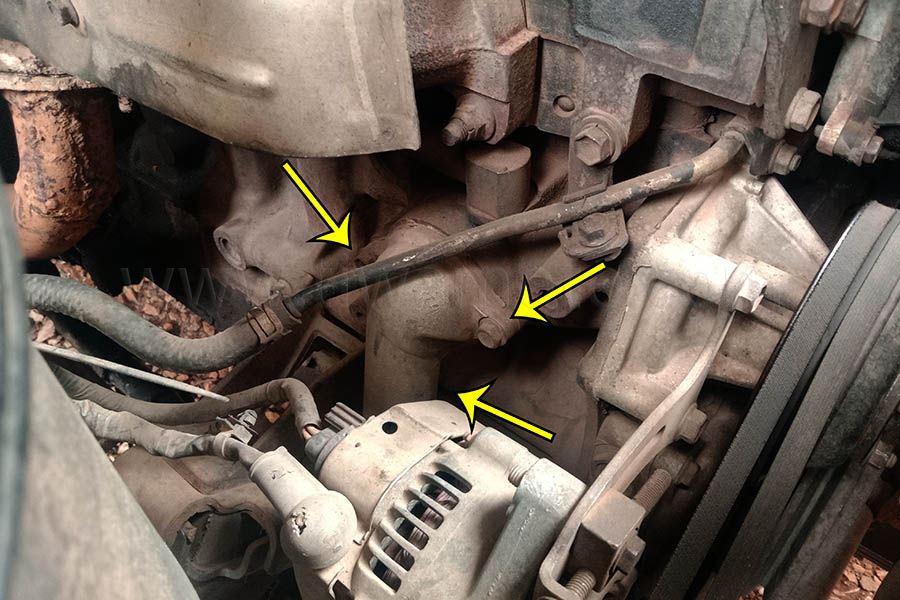
Since the inside of the cooling system pipe is filled with cooling water, drain it before work.
If you forget to work, you will get soaked, so be careful.
Cooling water will be reused, so drain it into a clean basin.
Also, antifreeze contains ethylene glycol, which is harmful to animals and plants, so we can't just throw it away.
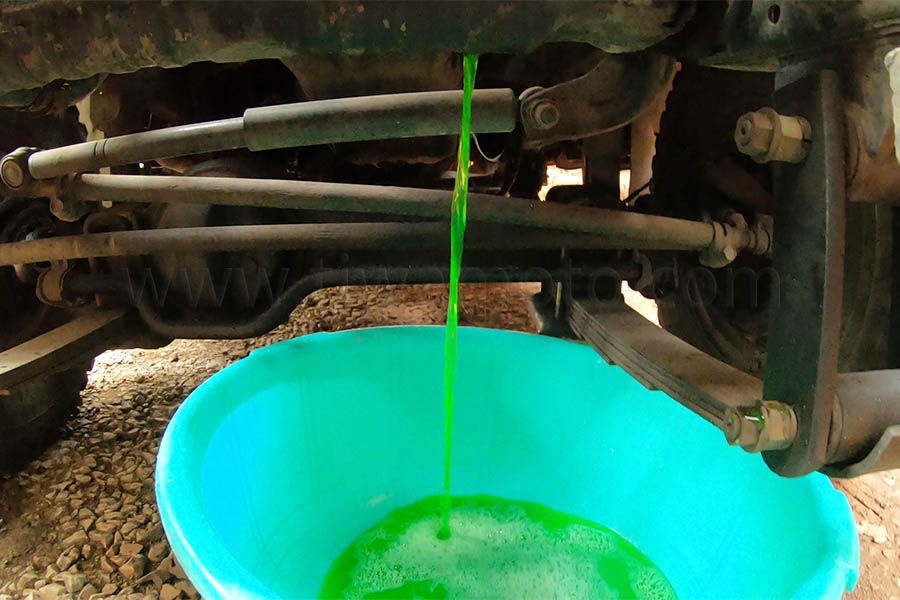
It reminded me of the old days of bathclin, melon soda, cooling liquid of that color, and even candy stores had powdered drinks of this color that were dissolved in water for 10 yen.
After draining water, remove the cover bolt and hose tube covering the thermostat.
The car is tall, so you don't need to jack it up to get into the bottom of the car.
The inside of the engine room is also empty unlike modern cars.
There is no need to remove this to remove that, so any work is easy to do, which is another reason why I love this car.
Even if there is a problem in the bush, it can be quickly troubleshooted and repaired.
No ABS, no airbags, no computer control at all.
If you remove the negative of the battery, you can work with peace of mind.
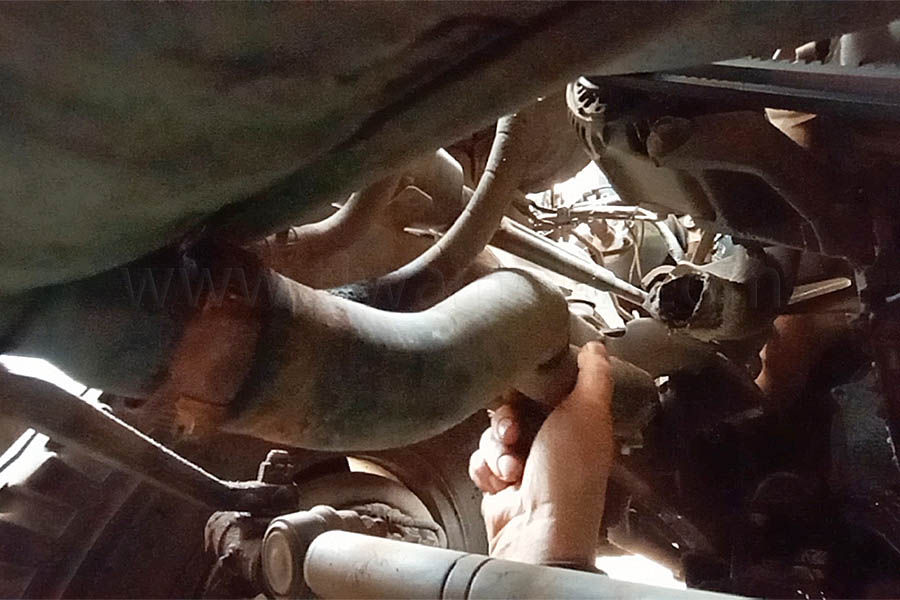
Loosen the zip ties and remove the tube
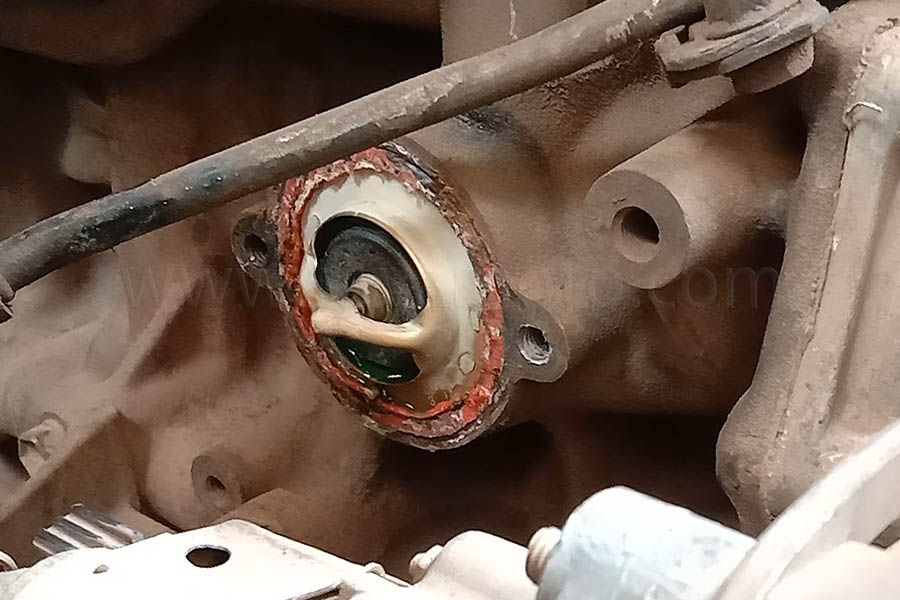
old exposed thermostat
At first glance, there seems to be no problem as there is no foreign object caught, but 20 years of opening and closing work has accumulated dots.
Thermostat-kun, anyway, thank you for your hard work!
Comparing new and old thermostats
The old and new are very different in shape.
As you can see at a glance, the older ones have a larger diameter.
For the time being, it will work as long as it is slightly larger than the diameter of the hole on the receiving side.
The opening and closing temperature is 76°C for the old one and 82°C for the new one.
The memory of 79°C was a mistake of 76°C.
The optimum temperature for a 1HZ engine is written on the internet as 86 degrees or 88 degrees, so it seems that the new one can keep the engine at the proper temperature.
The old thermostat has always felt that the engine temperature drops too much on long descents.
Hopefully a 6°C rise from 76°C to 82°C will fix that too.
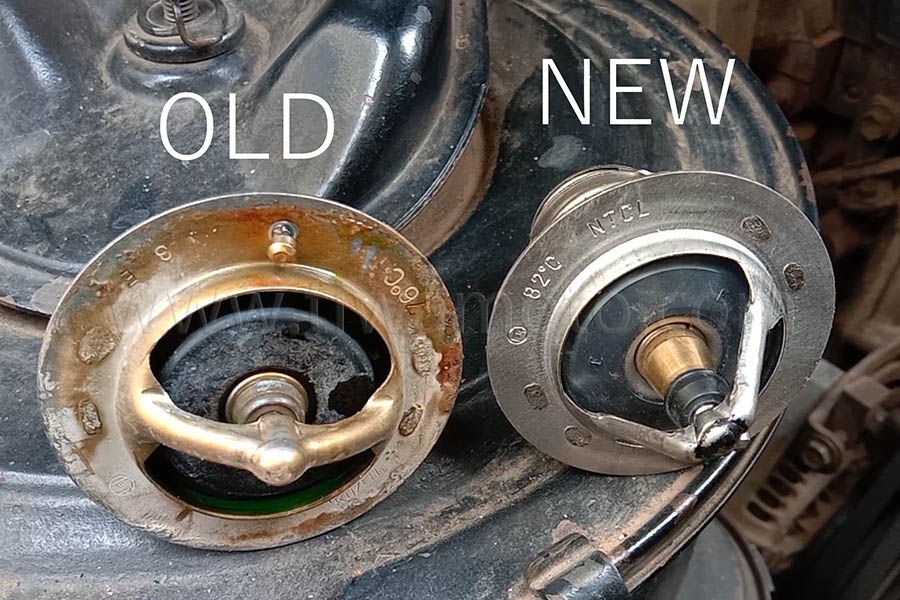
New and old, the shape has changed quite a bit
The diameter of the new one is one size smaller.
I should have measured it, the diameter of the old one I have is 64mm,
The diameter of the opening and closing flights is about the same.
The material is rubber, but is there metal inside?
Seen from the side
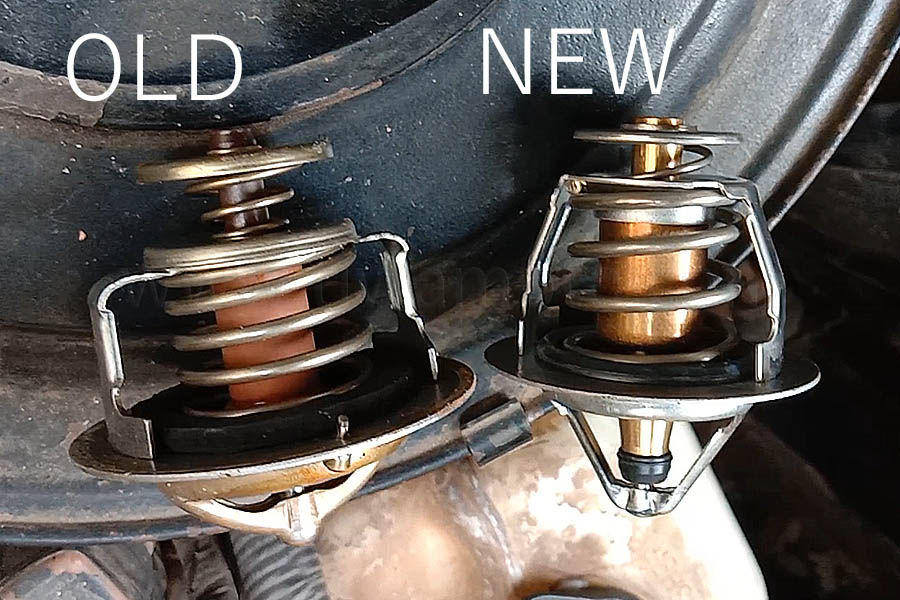
The new one is more slender and the opening and closing stroke seems to be a little larger
Old thermostats have thick and sturdy metal and rubber parts.
It is new and the overall length is slightly longer, and the opening and closing stroke seems to be slightly larger.
Newer pistons are thicker.
That's the difference.
When the engine gets hot and the thermostat opens to the maximum, the new one has less resistance and seems to be able to earn more cooling water flow.
Try to match the new thermostat to the installation location to see if it can be used immediately.
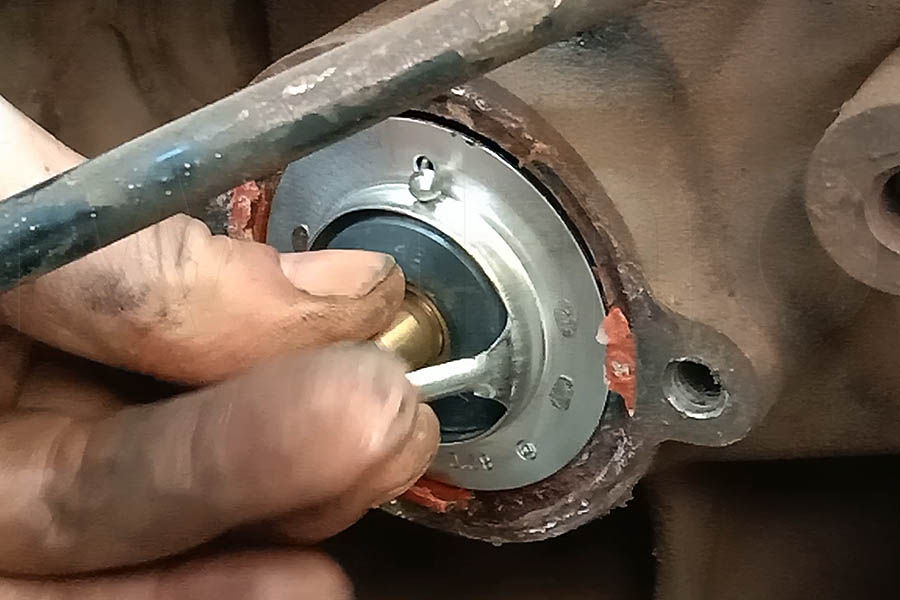
quite barely,
When I applied a new thermostat, the size was barely usable.
If you use plenty of silicone gaskets, you should be fine.
Installation work started!
Peel off all the sticky old silicon, scrape off the parts where the metal parts touch with an iron file, and scrape off foreign substances in other places with a flathead screwdriver, a hacksaw, sandpaper, etc.
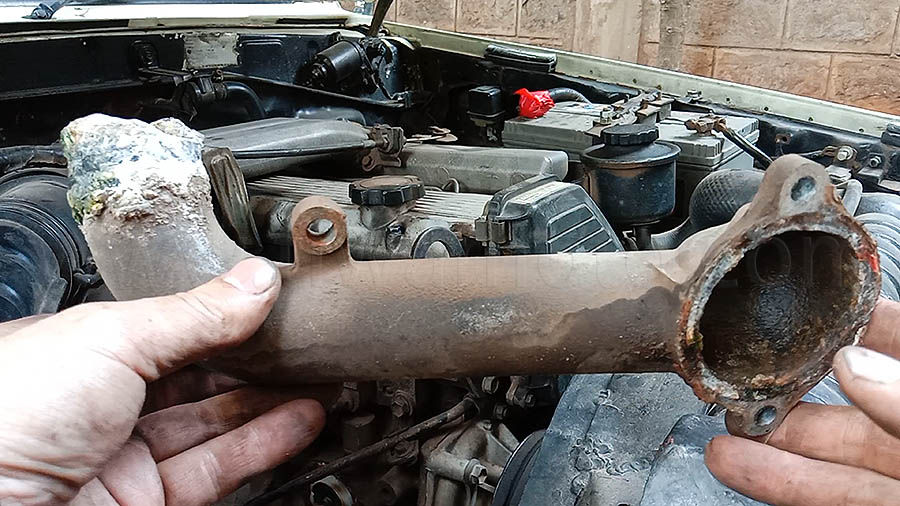
The white crystals must be a component of stop leak
I have an old, slightly damaged radiator, so I mix it with Stop Leak.
If you put this in, even if the cooling water leaks out, the leak will stop immediately.
Maybe that's the cause, or this crystal forms where the leak is and prevents the hole.
It seems that the part where the crystals are clinging to each other has been leaking and blocking repeatedly, and there was even something like green moss.
Moss?
After scraping off the white crystals, the metal part was not damaged so much and can still be used.
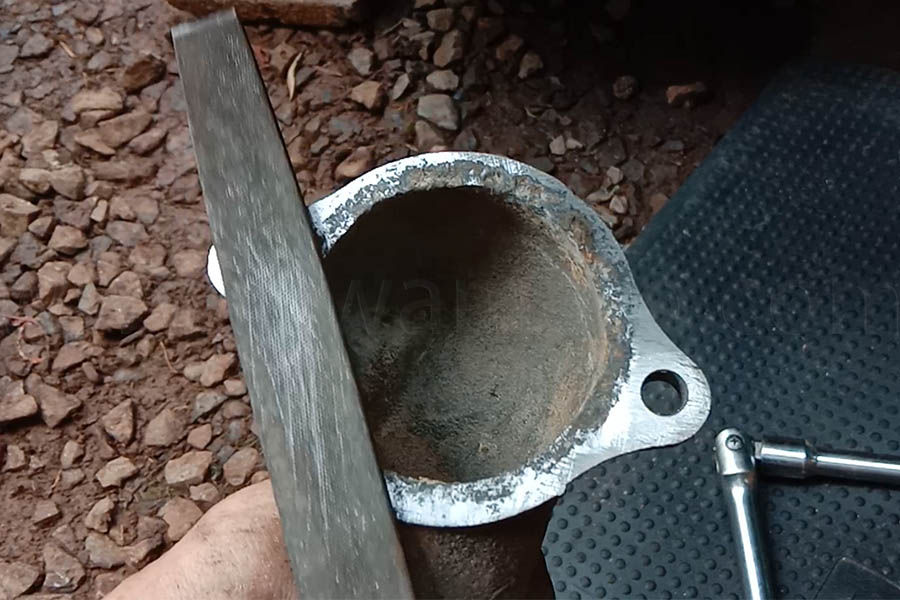
prepare the contact surface
Clean the interface between the thermostat housing and the engine.
Since the housing is made of aluminum, the parts that come in contact with the iron engine block have some corrosion.
This is called galvanic corrosion of dissimilar metals.
Aluminum is easier to ionize than iron, and is positively charged and corrodes rapidly.
Corrosion is progressing on the side that comes in direct contact with the flow of cooling water.
This corrosion in 31 years.
I reused the rubber gasket around the thermostat.
Apply a generous amount of silicone to prevent the thermostat from playing.
Just paint the cover side, and then attach the cover and pipe.
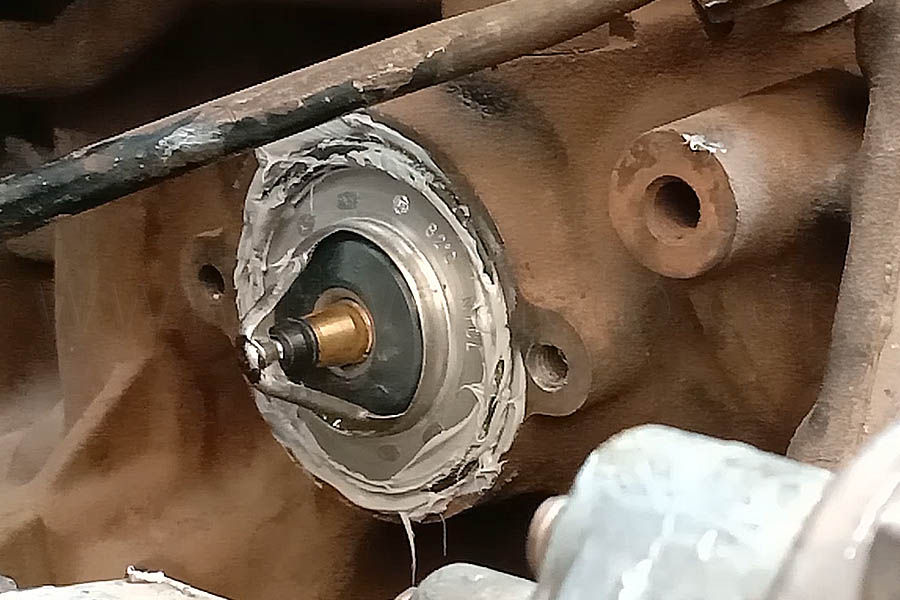
Silicon gasket, when I tried to fix the camera, it fell off once
I thought everything was going well, but my hand touched the camera, and when I took my hand off to fix it, the silicon-coated thermostat popped off.
The alternator right below caught it, so I was relieved that it wouldn't fall to the ground.
However, the silicon surface is messy.
I also applied silicon to the cover side, so I thought that if I messed with it any more, it would just get stuck in a hole, so I put it back in this state.
I saw the explanation that the jig (small valve) should be attached directly above, but I attached it to the side.
Cha cha cha cha! Are you okay? I'll fix it soon.
Early models didn't seem to have this jig, so maybe I don't need to be too particular about it, but it doesn't feel good.
Anyway, what is this jig for?
Is there a reason to set it on the top?
In terms of shape, it has a metal valve that blocks the flow from the radiator side and has a structure for reverse flow from the engine side.
Immediately after starting the engine, when the engine is cold and the main valve is closed, it must be to release the cooling water pressure from the engine side.
Is it to let the warmer cooling water escape?
If it's for drainage, it should be attached to the bottom.
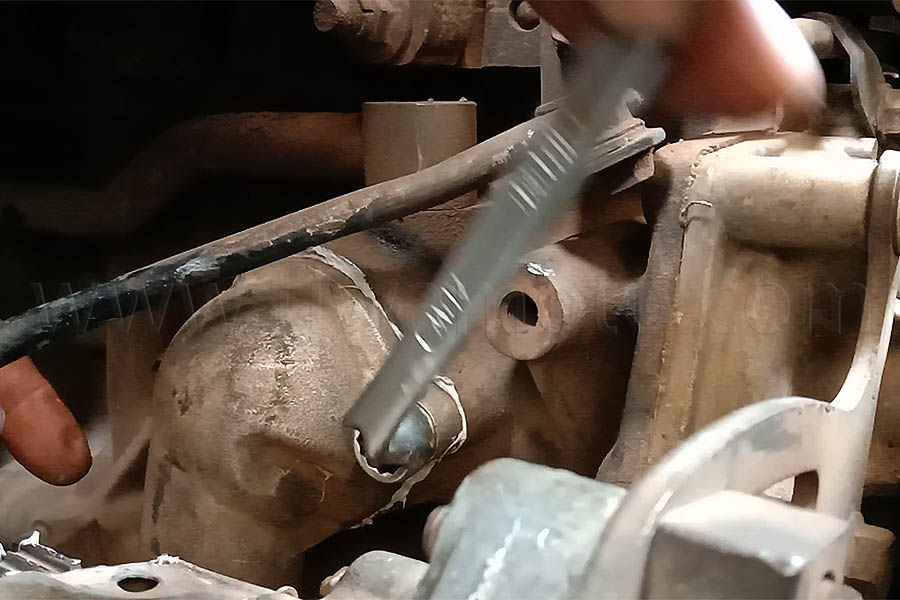
Tighten firmly before the silicone dries
Firmly tighten the three bolts that fix the thermostat housing, attach the hose pipe that connects the radiator to the engine, tighten the band firmly, and the work is complete.
After that, just close the drain cock under the radiator and return the cooling water to its original state.
Looking at the manual, the tightening torque is 18Nm for the 60 and 70 type rankles and 21Nm for the 80 type rankle.
Be careful not to over-torque if you use force to tighten it.
Just wait until the silicone dries.
While waiting, I killed the time by replacing the rear axle oil seal.
Since the oil seal was bad when I opened it last time, I bought two oil seals together with the thermostat. Even though they are the same, the shops are different.

Remove the 6 nuts, washers and cone washers and pull out the axle
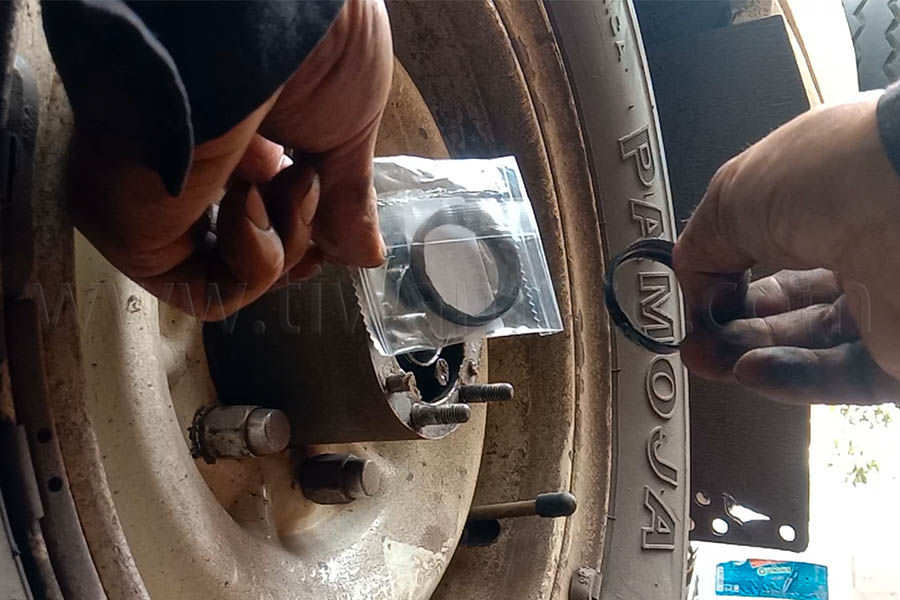
New oil seal to replace the worn out oil seal
Remove the oil seal with a flathead screwdriver and install a new seal.
Rubber parts are easy to replace.
This was done left and right while the liquid seal dried.
The damage to the old oil seal was so severe that the spring installed on the right side was torn. Why? I have a bad feeling.
The tightening torque for the stud that connects the axle shaft and the hub body is 33Nm, so be careful not to overtighten it.
Cooling water filling
After finishing the work, just 1 hour plus has passed.
The silicone gasket should have dried too.
So I'm going to return the cooling water.
This funnel is a standard accessory for your car, and is convenient in many ways.
This funnel has a hole on the side of the nozzle for air release.
If you squeeze the hose pipe several times with your hand, the air will come out well.
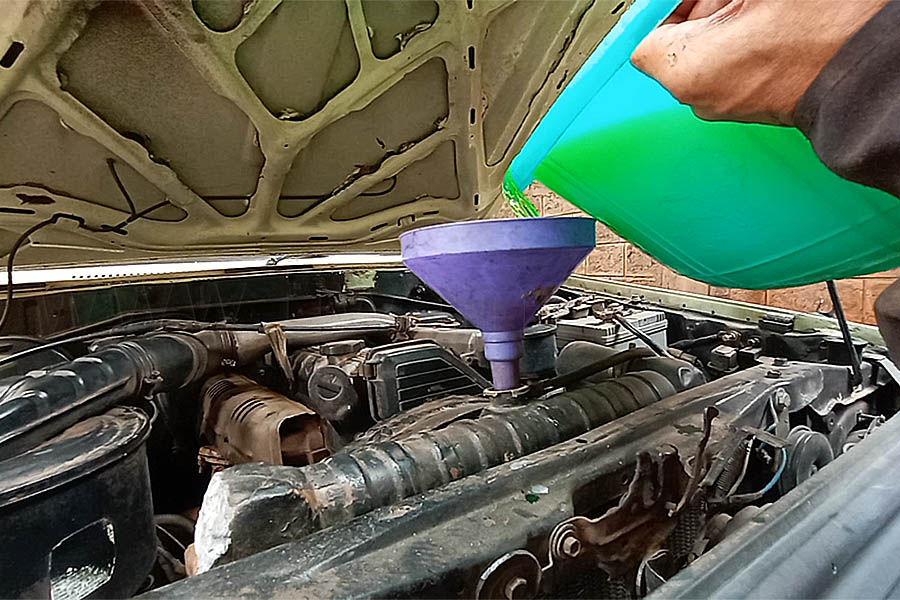
Add little by little to avoid spilling
It takes a long time because it goes in slowly.
When all the coolant has returned,
Start the engine and check that there are no coolant leaks.
Make sure the heater is fully open and that the cooling water is flowing through the heater path.
Finally, check the coolant level again.
Finish work by closing the radiator cap
Now, all that's left is the test run.
test run
Make sure that the thermostat is opening and closing properly.
It was confirmed that the engine warmed up more quickly than before and was kept at an appropriate temperature.
With a displacement of 4200cc, it contains 10 liters of oil and 10 liters of cooling water. It's a big engine for a passenger car, so the temperature doesn't rise immediately, but it only runs 4 to 5 km on the way down to the child's school. The engine temperature is now correct.
By raising the engine temperature sufficiently, the idling became very smooth, and it accelerated smoothly and powerfully.
The amount of stepping on the accelerator is reduced accordingly, so improvement in fuel efficiency is expected.
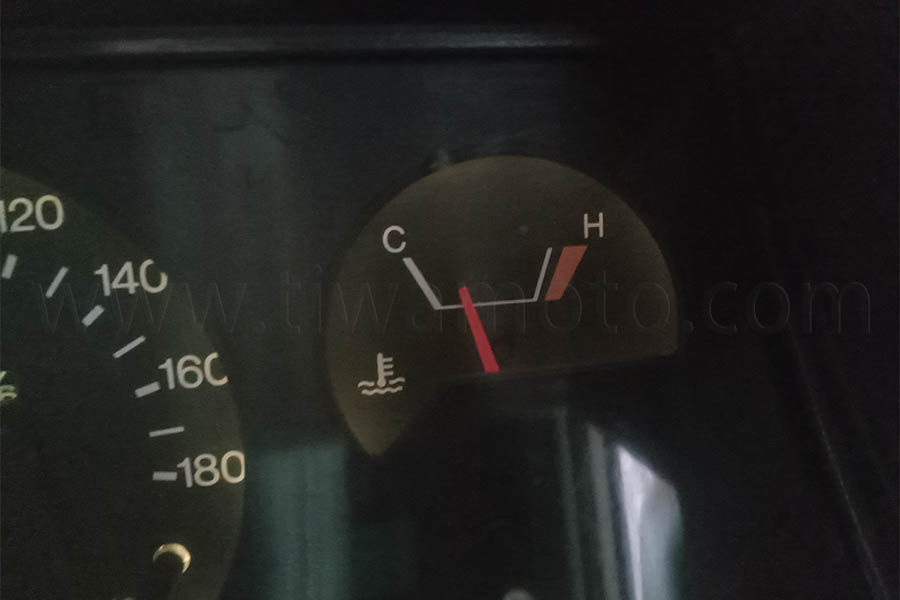
The water temperature needle now stays in this position
Above is the water temperature gauge when I returned from school in the morning.
It's early morning so it's still dark.
I ran about 200 kilometers after the work, but the fuel consumption improved by about 10% in town riding.
Before, it was probably because I was running only when the temperature of the engine had not risen.
I feel that the fuel consumption does not change that much when driving long distances, but I do not know because I have not tried it yet.
I replaced the thermostat, and the fuel efficiency and performance improved more than I expected.
If the performance changes so much, I think you should work faster.
By all means, if you have been riding your car for a long time, and if you have not changed the thermostat for many years, we recommend that you replace it.




Comments